Sporting Clays on the Bourbon Trail: Part III, White Dog Mash and Other Delights
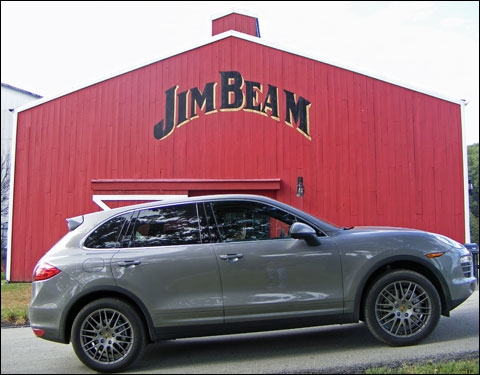
The itinerary was ambitious – eight days, seven posh sporting clays venues, 13 flats of shells and eight bourbon distilleries. Porsche had loaned us a 2011 Cayenne S SUV powered by a 400-horsepower V8 behemoth, while Connecticut Shotgun Manufacturing Co. supplied one of their marvelous A-10 American sidelock over/under shotguns. In Part I, we had visited Nemacolin. Part II took us to the Elk Creek Hunt Club. And now, in this third installment, we reach the distilleries for the ultimate experience in fine bourbon.
The Elk Creek Hunt Club served as the staging area for our blitz on the Kentucky Bourbon Trail. Over the next 48 hours we would sample bourbons from Buffalo Trace, Wild Turkey, Maker’s Mark, Heaven Hill, Four Roses, Woodford Reserve and Jim Beam.
We had established three rules for the trip. No shooting after booze, adhere to the designated driver mandate and never, ever stay in a B&B. Two of them we followed, the other we broke on this leg of the tour.
Since my traveling companion never acquired a taste for bourbon, she eagerly stepped up as designated driver. She immediately took advantage of the Porsche Active Suspension Management (PASM). A $3,980 option on our Meteor Grey Metallic Cayenne S, it provides management of the shock absorber damping. (The PASM also regulated the air springs that allowed the SUV to automatically squat when the doors or tailgate opened.)
The PASM enables the driver to calibrate suspension performance between normal, comfort and sport modes. We had been devouring the Interstates and back roads in normal. We discovered that the sport mode is ideal if you’re manually shifting the eight-speed Tiptronic transmission (although not mandatory). But since my traveling companion prides herself on never having received a speeding ticket, she selected the comfort mode for a reasonably cushy driving affair.
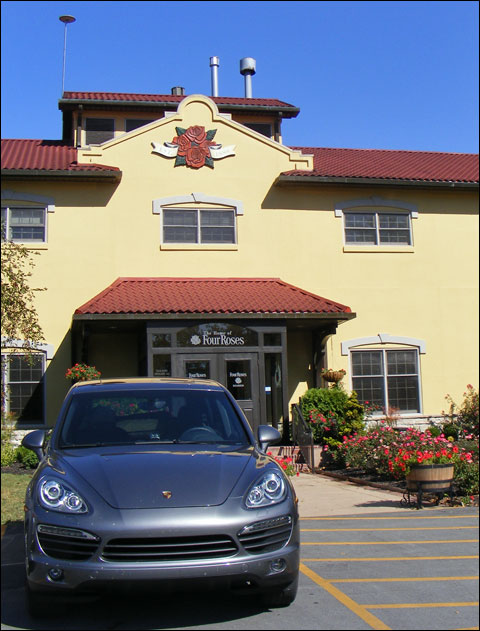
She went about finessing the settings on the steering wheel, seat and mirrors. Pleased with the results, there was one final adjustment. Upon starting the 400-horsepower V8, she slipped into Mom mode – satisfied that she had tamed the Porsche Cayenne S for a leisurely drive on the highways and byways of the Kentucky Bourbon Trail. She radiated an air of blissful self-satisfaction during the two hours to our first distillery visit while my right foot tapped the staccato of a cornered rattler.
We entered the Bourbon Trail from the north via US 127. For the uninitiated, US 127 hosts the world’s longest yard sale. It officially runs for three days in early August – spanning Illinois, Kentucky, Alabama and Tennessee. But driving through quaint towns along US 127 chronicles a community of flea-market diehards – the kind of folks who leave up Christmas lights year-round.
US 127 cuts through the state capitol of Frankfort, where our first distillery visit was Buffalo Trace. Like nearly all the bourbon distilleries on our itinerary, Buffalo Trace presented a sprawl of towering Victorian-era brick buildings, exposed ducts that traversed the plant via trestles and struts, railroad tracks, roof-top water tanks and all the trappings of America’s Great Industrial Revolution.
The massive presence of brick, though, conveyed an authority and authenticity that distinguished Buffalo Trace. Bourbon is aged in charred oak barrels and Buffalo Trace stores them in the brick warehouses abundant with windows to promote temperature control. Most other distilleries age bourbon in modern, colossal metal rick warehouses designed to optimize the seasonal temperature fluctuations that distillers exploit for the distinctive flavors that arise with rotating the barrels from floor to floor. Over time, the rickhouses gradually turn black with mold attributed to the evaporation of alcohol fondly called angels’ shares.
Economies of scale in warehousing make even more sense when you understand that the distilleries produce multiple brands. The copper stills at Buffalo Trace brought forth 15 different spirits. Including its eponymous bourbon, the company made Blanton’s, Ancient Age, Van Winkle plus Sazerac rye.
The high concentration of bourbon craftsmanship in Kentucky comes from mingling a natural fluke of nature with a spark of applied genius.
Bourbon County water is high in limestone, which filters impurities. The hot summers and Southern winters make the oak barrels expand and contract – varying the contact of the clear sour mash with the caramelized sugars that arise from toasting the oak barrels. The Master Distiller will nurse the exposure of the clear sour mash to the sugars through their signature rotation – nurturing the rich amber hue of bourbon over time.
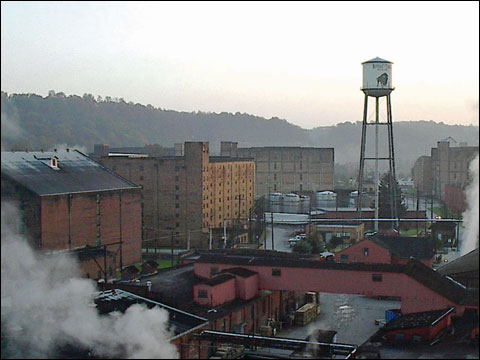
As with barrel rotation, the proportion of yeast, corn, barley and wheat are tightly guarded secrets that have distinguished the flavor of individual bourbons for over a century. In terms of aging, two years is the minimum as established by law. Most bourbons are aged four to 12 years. Federal regulations specify that bourbon cannot be distilled above 160 proof and must be bottled at no less than 80 proof.
Walking across the parking lot at Buffalo Trace divulged the pungent fragrance of White Dog Mash, and provided a clue as to what lay in store.
The Visitor’s Center took on a format that would become familiar. It combined the gift shop with tasting area. I started with a snort of Buffalo Trace White Dog Mash. It’s made from their rye-based Mash #1. It comes straight from the still at 62.5% alcohol. Basically, it’s white lightning light and tastes smoother than you’d expect. Next came the 101-proof, single-barrel Eagle Rare bourbon. This small-batch spirit tasted spicy and powerful with a finish that made your throat feel about a mile long. Finally, a glass of Buffalo Trace Cream Liqueur was placed on the bar. It proved a superior alternative to Bailey’s Irish Cream – certainly lent more finesse to this category of liqueurs.
Back in the Porsche Cayenne S, a warm, Buffalo Trace glow produced my own personal comfort mode. My traveling companion delighted in driving at her own relaxed pace – underscoring that a Porsche is a joy to drive at any speed.
Continuing on US 127, our next stop waited 20 miles south at Wild Turkey, about three miles east of Lawrenceburg. Heading east on US 62, the two-lane road through the Kentucky hills slices through the Wild Turkey distillery. On one side is an armada of rickhouses, the other Wild Turkey’s massive distillery.
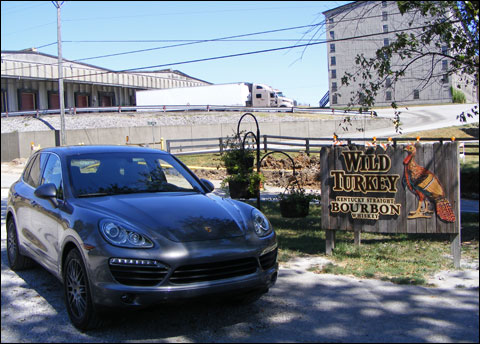
The Wild Turkey moniker stuck after distillery executive Thomas McCarthy took some of the 101 proof samples on a wild turkey hunting trip in 1940. The following year, his hunting buddies asked him for “some of that wild turkey whiskey.”
Wild Turkey is sort of the Paul Bunyan of bourbons – bigger than life. Maybe it’s the astronomical alcohol content of the single-barrel spirit, or the name that carries the theme of every country-western song ever written.
In the face of the Wild Turkey legend, the distillery’s Visitor’s Center seems somewhat modest. Open the door of the bungalow and it appears that you entered an old general store. The tasting area is in the rear.
I started with Wild Turkey American Honey Liqueur. That extra sweetness certainly tamed the 101-alarm fire of Wild Turkey Bourbon. The honey softens the front of the palette but you can feel the authenticity of the bourbon as it goes down. Call me crazy, but I thought Wild Turkey American Honey Liqueur would a great base for pancake syrup or a sweet fortification to a hearty bowl of oatmeal.
I moved on to Wild Turkey 101 Kentucky Spirit Single Barrel Kentucky Straight Bourbon Whiskey. It comes in a horseshoe-shaped bottle with crinkles along the top – implying a premium brand over the standard Wild Turkey bourbon. The flavor warmed your Adam’s Apple very nicely – ideal after a winter’s day of hunting.
Finally, I paid homage to Jimmy Russel, Wild Turkey’s Master Distiller since 1954. The company has spun off his own Jimmy Russel brand Russell Reserve that includes 10-year-old bourbon, 6-year-old rye whiskey and 10-year-old-rye whiskey. I was served a taste of Russell Reserve 10 Year Old Bourbon. The 90-proof elixir came across as sweet and nutty with hints of rye.
All I can say is that you leave Wild Turkey in a very good mood, elevated to a higher plane after climbing into the Porsche Cayenne S.
This leg of the trip took us on westbound along the Bluegrass Parkway. While the name evokes romantic notions of banjo strumming in box cars and midnight bootleg runs, it’s a major artery that connects I-65 with I-75. The Porsche Cayenne S glided in comfort mode toward our next distillery, Maker’s Mark.
Exit 42 fed us onto the two-lane US 555 that cut through verdant hills. Even at the leisurely tempo preferred by my traveling companion, the 400-horsepower V8 of the Porsche Cayenne S emitted the low rumble of a lioness calling her cubs to feast on a wildebeest. As the designated bourbon taster, I reached over and turned off Willie’s Place on the satellite radio in order to savor the engine’s resonance.
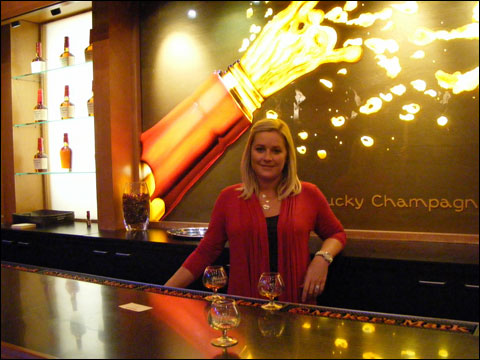
Maker’s Mark communicates a subtle distinction from the others that we visited. You may not recognize it until you set foot in the Visitor’s Center. The covered bridge and assorted out buildings are just a bit too precious, as though restored by a theme park romantic. Then you enter the Visitor’s Center… a suave, midtown club with an illustration of a champagne bottle popped open framed by backlit shelves displaying Maker’s Mark. To the faithful of a straight-up gullet raw shot, Marker’s Mark has abandoned the Kentucky holler for an amber immersion in urban elegance finely tailored for a bourbon Manhattan.
Still, when you belly up to the tasting bar, it’s Maker’s Mark ala testosterone poured straight from the bottle with the prominent red wax drip.
I sampled Maker’s 46, which the distillery hails as “Our 2nd big idea.” The Master Distiller aims for a front-of-mouth taste blast of the 90 Proof Maker’s Mark bourbon, but Maker’s 46 reveals the vanilla carmelization from the French Oak staves in the aging barrels. It’s the longer aging with French Oak that delivers the lingering fresh-baked pleasure of vanilla, maple and cinnamon to the fully matured Maker’s Mark bourbon.
One more distillery awaited us on the day’s agenda before we headed to Bardstown for our evening’s accommodations (and the place where we broke the third rule of the trip).
In the Maker’s Mark parking lot, my traveling companion commandeered the radio, powering on Willie’s Place. Next stop: Heaven Hill.
Never heard of Heaven Hill? Well, maybe their spirits ring a bell. As America’s largest independent distiller, the company manages 31 different brands of whiskey, bourbon, tequila, vodka, rum liqueurs, some of them comprising of multiple brands. The Visitor’s Center, though, mainly centers around the bourbon: Evan Williams, Elijah Craig, Henry McKenna, Fighting Cock, Old Fitzgerald and Parker’s.
Entering the parking lot, the view was dominated by blackened rickhouses.
The Visitor’s Center presented a curved facade that held a surprise inside very much like a Tootsie Roll Pop. First there was the Visitor’s Center tour of interactive exhibits that took us through the bourbon-making process and the history of the brands; then the group was led into a barrel-like tasting room that occupied the inner core of the building.
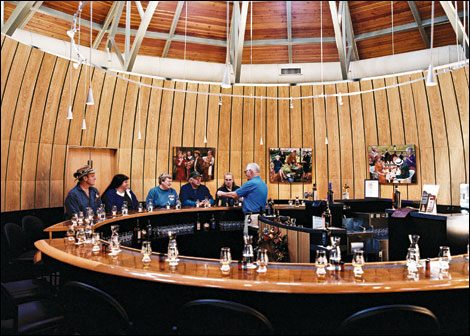
After a quiz in different tastes, the resident expert poured 18-year-old Elijah Craig. We were advised to evaluate it on color, aroma, taste and finish. The 18-year-old Elijah Craig hit the mouth with hints of maple and vanilla then kicked in with a strong back-of-mouth, 90-proof afterburner.
That drink was followed by a 10-year-old Evan Williams. It possessed lift-off intensity, followed by smoke, citrus and a hint of that loveable White Dog Mash.
Outside in the Heaven Hill parking lot, after the windowless tasting room, evening came on suddenly. A musky aroma carried on the breeze – the breath of the rickhouses circulating the air through oak bourbon barrels. Inside the Porsche Cayenne S, we dropped the window to savor the perfume of the Kentucky Bourbon Trail. She hit the start button on the dash board and the engine contributed its own primal luxuriance to the lush twilight.
Bardstown is a storybook town with a fabled reputation as the heartbeat of the Kentucky Bourbon Trail. The Porsche Cayenne S crept through the historic district of Federal or Georgian architecture spanning the 1780s to 1850s. The Nelson County Courthouse, the center of a traffic circle, exudes a grand carousel effect. A steep, pitched roof, four chimneys and rainbow arch are punctuated by a tower on the 1892 emblem of law and order now turned visitor center.
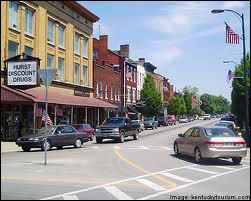
North Third Street is the main artery through Bardstown – a time warp of family businesses, Farmers Bank & Trust and breakfast joints that you know serve up platefuls of breakfasts heaped with the kind of love and dedication that Denny’s could never match.
You can rationalize the economic arteriosclerosis in Bardstown, but as we passed through downtown to the 1970s graft of commercial stretch, a sense of foreboding tightened its grip: nothing personal about Bardstown, but instead that deep-seated dread of B&Bs.
We couldn’t find a hotel for the night and instead broke our cardinal rule of road trips: never stay at a B&B. There’s just something weird about B&Bs, like getting a colonoscopy by your cousin.
B&B proprietors forever have a point to prove, and their self-righteous notions about a balanced life invariably lead them to some forlorn Victorian chronically exuding aromatics of bad meat and Raid. Experience has taught us that you should always request a ground-floor room and make your vehicle ready for a quick get-away on the chance your host is bi-polar.
A prevailing sense of decency prohibits us from revealing the actual name of the Bardstown B&B, but you’ve already stayed in the room: baby-blue latex over peeling wallpaper and a four-poster bed draped with mosquito net accompanied by mismatched Edwardian furnishings that in the fog of torrid sex may momentarily attain the majesty of genuine antiques only during climax.
The neighboring Italian restaurant, in a renovated chicken coop they called a barn, was closed on Mondays. After hauling in our bags, we returned to Historic Bardstown in search of dinner.
We walked North Third Street like a couple of Stupido Americanos trying to find a restaurant open on Mondays. We must’ve looked terribly lost because an elderly gentleman intervened, asking if we needed help. He appeared straight out of central casting, like the guardian angel, Clarence Odbody in “It’s a Wonderful Life.” He steered us to a Bosnian restaurant up the street. The schnitzel wasn’t half bad.
Our B&B proprietor had already informed us that breakfast was served promptly at 9:00. We were loading up the Porsche Cayenne S, making trips up and down the back stairs as he and his wife sat in the courtyard smoking cigarettes and watching us. It looked like he still wore the same clothes from the day before – more student mover than hospitality ace, while his gaunt wife sucked on her cigarette as though it were her last tenuous lifeline to planet Earth.
At about 9:15, with our belongings stowed, we entered the dining room all set to chow down. The tables lay empty. Then two servings of pancakes with blueberry compote (please don’t call it sauce) sitting on a table for six caught our attention. Apparently, our host was dead serious that breakfast arrived at 9:00 sharp, because the pancakes had been waiting for us some 15 minutes and by now took on the effect of that that plastic food you see in the windows of sushi restaurants. We requested fresh pancakes – sparking a vicious argument where he defended his wife’s inability to keep up with all the guests (the place must have been haunted) and bellowed that I knew nothing about hospitality. Us two guys slung barbed insults at each other until he conceded, deducting his congealed pancakes from the tab.
B&B’s? Never again!
We stopped at Mammy’s Kitchen in downtown for eggs, bacon, biscuits and plenty of black coffee. Mammy’s Kitchen, like Julia Child’s kitchen, deserved a place in the Smithsonian. It stood for everything good about authentic American food and the values of the hard-working people who serve it up.
With three more distilleries in front of us that day, I climbed into the passenger seat of the Porsche Cayenne S, fortified with a heapin’ good bellyful of Mammy’s.
If you’re not a bourbon aficionado, chances are the name “Four Roses” conjures up a skid-row derelict passed out in a dingy pawnshop doorway. That means you would be thinking of the American blended whiskey and not the bourbon. Thus passes a sad era in the annals of Kentucky bourbon. Four Roses bourbon had been made since 1860, but when Seagrams bought Four Roses in 1960 the New York bigwigs in the corner office decided to ship the stellar Four Roses bourbon exclusively overseas and then bastardize the brand into a cheap whiskey in the Lower 48. After Kirin bought Four Roses in 2001, the new owners recognized that the popularity of Four Roses bourbon in Japan would carry the day back in the U.S.
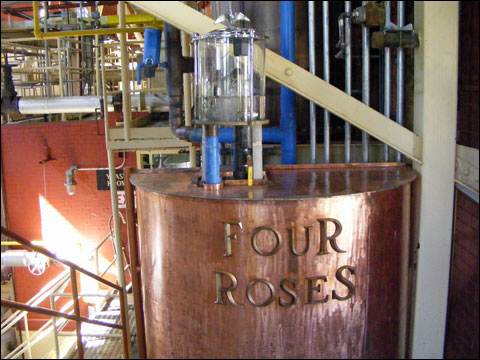
Master Distiller Jim Rutledge was charged with the resurrection of Four Roses on its home turf, and based on the samples I tried he deserves a hearty pat on the back.
Today, the name Four Roses appears on seven different bourbons. Two of them are premiums only sold in Japan. The single barrel, small batch and Yellow are available in the U.S., Europe and Japan. The Mariage Collection and Limited Edition are for American consumers.
The Four Roses Visitor’s Center is housed in a pale mustard-colored building of Spanish Mission design that dates back to 1910. You enter the tasting area through a narrow arch, where the bourbon is served at a small bar.
The mainstay Four Roses combines five yeast strains with two separate mashbills to produce 10 distinct bourbon recipes. Different amounts of each of those recipes are used to create Four Roses Yellow Label. At 80 proof, Four Roses Yellow is relatively mild, giving rise to flavors of apple and pear with a sweet finish.
From Four Roses Yellow, I moved on to the Four Roses Small Batch. Like the Yellow, it’s also a blend. The four bourbons that come together in the Small Batch reward you with the essence of berries, maple-cream and spice that expands into bourbon heat from the 90-proof spirit.
My Four Roses tasting concluded with a wee dram of 100-proof Single Barrel. The front of the mouth gave forth plums and cherries then assumed a prolonged zesty finish. For 100 proof, it was exceptionally smooth.
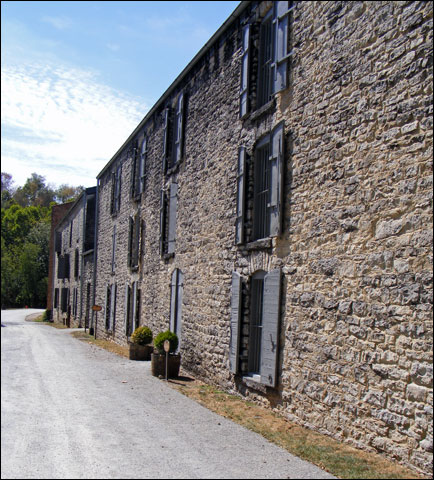
Now, for the second consecutive day, my morning was awash in the warm radiance of Bourbon Trail hospitality. I settled in for an ever-so placid, 20-mile drive to the vicinity of Versailles, where we would drop in on Woodford Reserve.
Of all the distilleries on the Bourbon Trail, Woodford Reserve is the most gentrified. Turn onto the lane that leads you to the distillery and you’re among classic Kentucky thoroughbred horse farms. After a morning of bourbon tasting, ensconced in the passenger seat of the Porsche Cayenne S, you can easily slip into the reverie that the Pearly Gates lay right around the bend.
Woodford Reserve rewards you with picturesque vistas of race horses grazing on rolling green hills sectioned by traditional white fences. The distillery’s limestone buildings, which date back to 1812, have been restored to their original operating condition. The limestone came from a lode on the property that acts as natural aquifer to purify the water. Inside the distillery stand three massive copper still pots.
Woodford Reserve truly is a small-batch bourbon. Barrel aged for eight years in the incomparable limestone warehouse, Woodford Reserve produced 146,000 cases in 2009. Jack Daniels, meanwhile, shipped some 10 million barrels the same year.
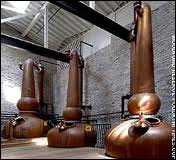
The Master Distiller at Woodford Reserve toasts barrels longer than other Kentucky distilleries. This involves burning the inside of the oak staves to thoroughly leach out the flavors of caramel, butterscotch, toffee, vanilla and nuts with aging. And upon sampling their 90.4-proof Woodford Reserve, those were the tastes and fragrances that distinguished the experience.
It was only fitting that the last distillery on our itinerary would take us to Happy Hollow Road – the home of Jim Beam. My traveling companion entered the final address into the integrated GPS, providing instructions for the 75-minute drive.
Like Woodford Reserve, Jim Beam preserves the rural atmosphere of the mid-1800s, a turning point for the company when Jacob Beam charged his 18-year-old son, David, to run the business that today counts some two-million barrels aging in their rickhouses.
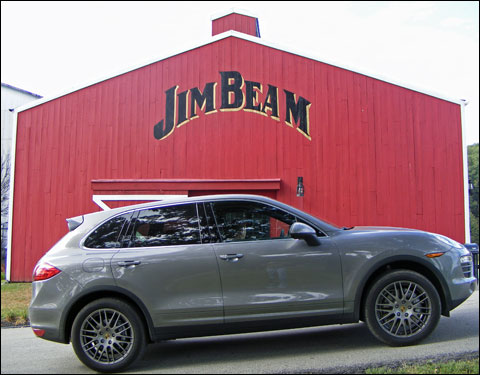
The Jim Beam distillery is a cornucopia of fine bourbons. There are 10 labels. Six of them bear the Jim Beam name. The remaining four include Knob Creek, Basil Hayden, Booker’s and Bakers.
The company calls their Visitor Center the Jim Beam American Outpost. It’s a cavernous red barn where Jim Beam fans stood three-deep for a sip of their favorite bourbons.
Our tasting began with Basil Hayden, a small-batch bourbon with a dose of double rye. Aged eight years, it comes in at 80 proof. The flavor packs a front-end, rye-edged wallop for its relatively low-alcohol content, but then mellows to a caramel finish.
Basil Hayden was followed by Knob Creek. The nine-year-old, 90-proof bourbon displayed almost the opposite flavors of Basil Hayden – starting with the caramel that burst into a peppery bath of rye. Certainly, a wonderful conclusion to my bourbon extravaganza.
As an active and willing participant on the Kentucky Bourbon Trail, I can heartily recommend the following:
- This trip is not for sissies (if you really want to go whole hog plus the postage when it comes to trying bourbon).
- All of the distilleries require an educational tour of their facility before you can participate in a tasting. Make sure you allocate plenty of time between visits, since the tours can last upwards of an hour.
- You’ll get drunk faster than you anticipate (especially when you start the day with White Dog Mash). Bear in mind that the bourbons will average a brain-pickling 90 proof. Have a sober, designated driver in your group – seriously.
- Don’t drink and shoot. We went for two days on the Kentucky Bourbon Trail without firing a single round (although I can tell you that after the first visit to Buffalo Trace the Connecticut Shot A-10 American started whispering to me from inside the case in the back of the Porsche Cayenne S).
- Avoid B&Bs if you want to save your soul.
The next installment of Sporting Clays on the Bourbon Trail takes us to the Rockcastle Shooting Center at Park Mammoth Resort, in Park City, Kentucky. If Frank, Dino, Sammy and the other guys in the Rat Pack shot sporting clays, Rockcastle Shooting Center at Park Mammoth Resort would be their spot. In the mean time, please follow the links below if you’d like to read the previous installments of Sporting Clays on the Bourbon Trail:
Sporting Clays on the Bourbon Trail: Part I, Nemacolin
Sporting Clays on the Bourbon Trail: Part II, Elk Creek Hunt Club
Irwin Greenstein is the Publisher of Shotgun Life. You can reach him at letters@shotgunlife.com.
Useful resources:
The Connecticut Shotgun A-10 American web site
The official web site for the Kentucky Bourbon Trail
The official web site for Bardstown, Kentucky

Irwin Greenstein is Publisher of Shotgun Life. Please send your comments to letters@shotgunlife.com.

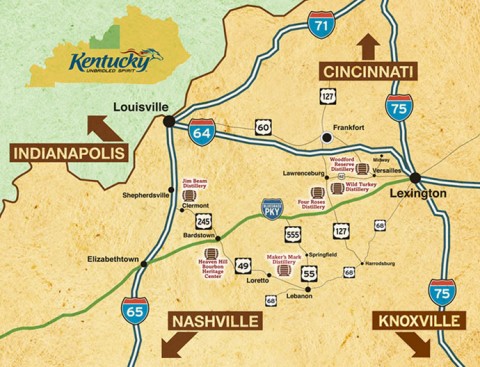

Comments